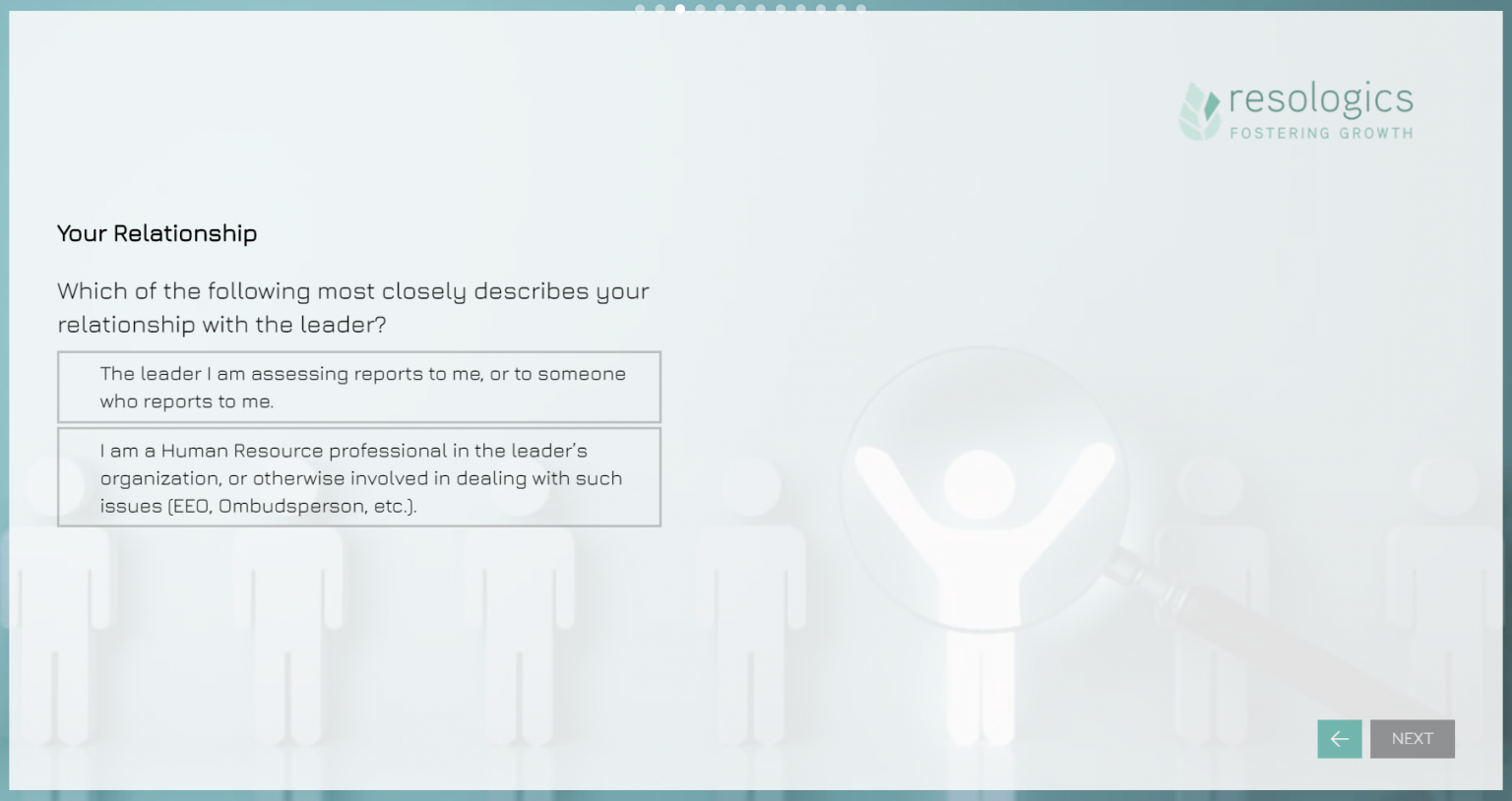Resologics helps organizations and people within those organizations be heard and resolve conflicts at the earliest possible stage. They act as a confidente and a trusted resource for folks within organizations to help them, and it’s been quite a journey.
To help organizations estimate the cost of the conflict they have in a team, they developed the “Cost of Conflict Calculator” with Pointerpro. This calculator gives organizations an indication of how much the existing conflict is costing them financially, providing them with a PDF report with feedback and recommendations for conflict resolution and consequently more cost-efficiency.
Who is Mark and what is his role at Resologics?

At that point, he started being trained as an ombudsman and as a team coach, and now, formally, he and his team call themselves organizational ombuds.
Mark: “The idea that conflict in organizations is something that is important to deal with, is something that a lot of organizations, and a lot of leaders, don’t see. We wait until something explodes and then we call in the emergency crews and let them take care of it.
So still half of what we do is that emergency crisis: a company we don’t know calls us, we go in and put out the fire, if you will.
But the other half of the cases or companies that we’re dealing with, whether it be full profit, software building companies or government agencies, schools, etc.: we’re there all the time, embedded within that team, so they can call us (anybody in the company can call us) and they know they can have a confidential conversation about wat’s going on.
And that’s what we do! It’s been a fun ride, we have six of us on the panel right now, that do this type of work, and we’re hoping to expand that. We think that every company in the world should have this service at their disposal.”
The cost of conflict calculator
Mark: “When we first started this business, we had to do marketing, like everybody else. But it’s not an easy sell. So we came up with the idea of “what is our value proposition?” If somebody is going to spend X amount of dollars to put to us to do our service, what are they gaining by doing that?
So we build a “Cost of Conflict Calculator”. It’s just a few questions, it takes the data in the background and compares that to industry standards for salary and for costs and curve for replacing people, and other measures.
It gives the person a dollar figure on the other end on what it’s costing them to have that conflict in their team right now.
We already built a calculator back in 2014 on a private server and paid a developer to build it, and it worked great. But over the course of 4-5 years, it needed updating, the tool broke and things had changed.
We decided: “You know what, let’s go looking for someone who does this, and does it really well!”
“Through a bunch of investigations, we found Pointerpro, and we decided to give it a try. We signed up and found out that it just works fantastic.”
So the formulas in particular: there are some complex calculations going on-it feels like complex calculations to me-to develop the report and the answers for folks in the background.
And that’s what we did, we made the change over to Pointerpro and had the PDF’s going out to folks, and it just works really, really well for what we need to have.
So it was replacing a system that we had custom-built before and… Boy, I can go in all sorts of different things on why I love it!
This gave us control over the look of it, the design of it, what people actually saw on their screens, it allowed us to change things on the fly as we saw that things needed to shift with what the clients wanted, and it allowed us to do the PDF reports, which is one of the big things you all focus on.
It’s one of the big takeaways: somebody just clicks that button at the bottom, and they suddenly have something they can deliver to a teammate, or deliver to someone else, and that is really something that “I hang my hat on” with all of this, that it’s not just a quick thing and they close the program. No, they actually have something they walk away with.”
The results
Mark: “The results of that for us: we get probably on average (i’m looking back on the last year) about 2 users per day. Which doesn’t sound like a lot, but all we need is 1 customer every 6 months out of something like this and it pays for itself 10 times.
“All we need is 1 customer every 6 months out of something like this and it pays for itself 10 times.”
It’s that kind of customer we’re looking for. So when I look back at some of the records where folks had put in their contact information, I regularly noticed they were already a client. They may not even mention to us that they use this online, but it’s part of their decision-making process-whether it’s at the end of their process or at the beginning.
For some of them, at the very beginning, where they are like “Oh my gosh, we have this major conflict happening on the team, let’s go out looking,” they come out at our calculator and they decide to fix this problem.”
Customer feedback
“The proof of success is in getting new clients out of it.”
Mark: “In our industry, one of the things we try not to do is collect personal information. From a marketing standpoint, that’s completely backward, right? Of course, you try to collect as much information as you can so you can be in contact with folks. But we make all of that optional on the assessments that we do.
That feels important: not to collect information. So not having that information makes it hard to know what people are thinking. We do get reactions, though. You get emails, you get folks saying “Hey that’s a fantastic tool, it works really well”, and we put some of those comments on the web page.”
But the real proof is in getting new clients out of this calculator. That’s real “proof in the pudding”, you know.”
The abrasive leader diagnostic: a new initiative with Pointerpro
Mark: “I have a whole new tool that we’re launching soon, I think even much more exciting than the first tool. It was born out of the idea that we’re using Pointerpro, and we have this amazing tool, what more can we do with that?
I was talking with your team-let’s back up a little bit. So about a year and a half, 2 years ago, I discovered in one of the teams that I was working with that they had a person they described as an “abrasive leader”.
That leads to a lot of distress in a team, when you have a leader like that. I have encountered that many times over the years, not knowing what to do with it. In this particular case, I decided to talk with some folks and learn a little bit more about this. And after finishing that case, I thought about the idea of how to get more of these cases and how we, as a group of coaches that specialize potentially in this type of coaching, could get more cases.
So, we developed, together with the Boss Whispering Institute, a personality or behavioral assessment. We call it the “Abrasive Leader Diagnostic”. It’s a very simple, less than 10 question-survey on your platform, that allows somebody to come up with a yes-no-maybe answer on whether they have an abrasive leader in their midst.”
The whole idea is, it’s a marketing tool, but the reporting on it is the big piece for us: people walk away with a recommendation on what to do about this issue that they have in their team.
I’m thrilled that we have this, because you have these complex calculations going on in the background that the user never sees. But they put in their information and they come up with a very definitive answer to what they have.
We’re hoping to be one of your customers for the Distribution Portal tool. We’re hoping to help a lot of folks with that, and maybe make some money with it, too! 🙂
Tips to digitalize your advice at scale
1. Make it personal
Mark: “One of the things I noticed right at the beginning, from a tech standpoint, is that I’ve been through all the tutorials (which I highly recommend) and did a couple of test surveys, just to get the feel of the system, because there is a learning curve to be able to build out.
Getting to know and use your tech service, whether it be the instantaneous chat or by developing a relationship to be able to email so you can have an answer in a few hours:
“It feels very personal, it feels like I have my own development team in the background, even though you have a lot of customers.”
That would be the tip: make it personal. Even though you know the system, there will always be questions that will pop up.”
2. Don’t work in a vacuum: collaborate
Mark: “It’s not only about the system, but also on how to set up the questionnaires. The Conflict Calculator was done in collaboration with four people, just to get everything we needed on there.
And then the Abrasive Leader Diagnostic was done in collaboration with just two of us, but we’re about to open it to a huge group of coaches that do that work. So we’ll have a much larger collaboration on that one. We expect that the questions will change, that the whole format might change, but at least we have a start, right now.
So that would be another piece of advice: don’t do it in a vacuum. It takes longer to do it in a collaboration, but that team spirit helps a lot.
3. Attract people to your assessment
Mark: “As soon as we have the final version of the Abrasive Leader Diagnostic, we’ll start running Google Ads on it, targeted directly with keywords toward HR professionals. We’ll start running additional ads with the Society for Human Resource Management, which is the biggest HR group in the United States, to be able to target specific folks within that group.
We’re going to do press releases in July and August, and we’ll be writing blog posts. We’re just in the midst of going on Forbes, we’re on the Forbes Coaches Council, and we’ll get something published hopefully by the end of the year.
We have many coaches that have speaking engagements, they’ll be talking about this as well.
And of course, we’re talking about it right now! 🙂







